Beyond global warming
Stressed oceans, globe-wide in the Anthropocene
The footprint of human activities on the planet is so profound that many scientists are already suggesting that we have entered a new geological era, the Anthropocene. From among these activities, those that are accompanied by large emissions of carbon dioxide (CO2) affect our entire planet and, especially, the oceans. Besides becoming warmer, the oceans are also growing progressively more acidic and less oxygenated. In this article we discuss the extent of these global stresses on the oceans after contextualising the disproportionate anthropogenic increase in CO2 and examining how it is distributed. We conclude with a discussion of mitigation possibilities that use the oceans themselves, stressing the urgent need to tackle the problem, especially during this present decade. Keywords: Anthropocene, warming, acidification, deoxygenation, global change.
The disproportionate increase in atmospheric CO2
One of the most graphic and palpable ways to help understand the magnitude of the problem of anthropogenic CO2 emissions is to compare the atmospheric concentrations of this greenhouse gas over recent decades with those of the past. We have had access to modern instrumental data since Charles David Keeling first began making measurements at an elevation of 3,400 m at Mauna Loa, Hawaii; now over 60 years ago, he initiated what is now known as the Keeling curve.
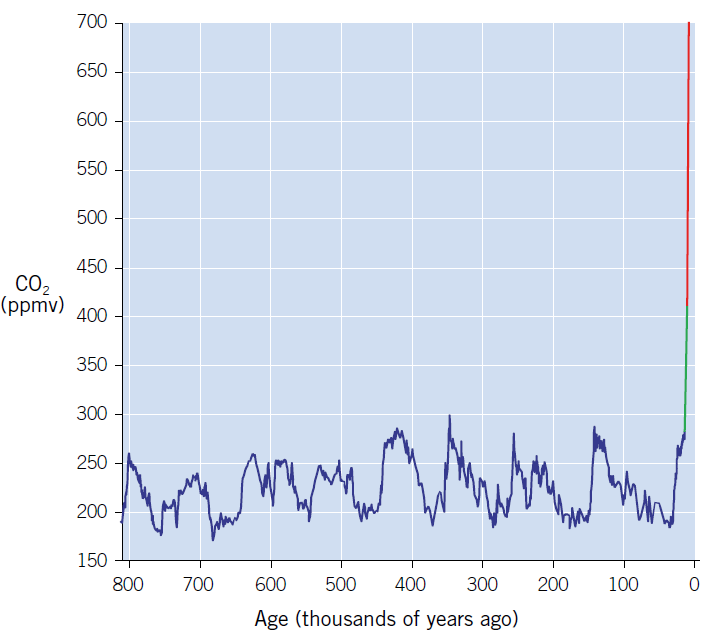
Figure 1. CO2 concentration in the atmosphere in parts per million by volume (ppmv) for the last 800,000 years and up to the pre-industrial era (data measured in Antarctic ice cores are shown in blue; data from Lüthi et al. [2008]), in the last few centuries and up to the present (shown in green, as measured in ice cores and instruments; data from The Keeling Curve project, Scripps Institution of Oceanography, University of San Diego, California), and in future projections up to the end of the twenty-first century, according to intermediate emissions scenarios (shown in red). / Source: Created by the authors from referenced sources
«The CO2 absorbed by the oceans affects a number of chemical equilibriums and results in gradual ocean acidification»
As can be seen in Figure 1, the continuous record of atmospheric CO2 for the last 800,000 years shows values ranging from 180 ppm during the cold glacial periods to 280 ppm during the warm interglacial periods. In this context, the current values – already above 410 ppm – have clearly fallen outside the range of natural atmospheric CO2 variability for, at least, the last 800,000 years. Depending on future socioeconomic models, energy policies and population growth, the concentration of CO2 in the atmosphere will take different trajectories, which could exceed 1,000 ppm by the end of the century according to the most pessimistic scenarios, or reach values below 500 ppm in the most optimistic ones (Fuss et al., 2014).
How is this CO2 distributed?
Fundamentally, the CO2 that humans release into the atmosphere is distributed into three major compartments: atmosphere, continents, and oceans (Figure 2). During the 2009–2018 period, it was estimated that 44 % of CO2 emissions went into the atmosphere, 29 % went into the continents (fixed by plants), and 23 % was absorbed by the seas and oceans, with the remaining 4 % representing the current mismatch between the calculation of global emissions and sinks (Friedlingstein et al., 2019). These calculations are independent and, because of their inherent uncertainties, emissions and sinks often do not match perfectly.
«Much of the excess heat experienced by the Earth due to the greenhouse effect is retained in oceanic waters»
A positive mismatch, as in this case, either means that emissions are being overestimated, or that sink estimates are lower than the actual values. We should be grateful, therefore, that not all the CO2 that humans release by burning of fossil fuels remains in the atmosphere and, most importantly, that it can be absorbed by plants and ocean waters. Were it not so, the concentration of CO2 in the atmosphere would be significantly higher, thereby aggravating the greenhouse effect and global warming. However, as we will discuss below, the CO2 absorbed by the oceans affects a number of chemical balances and results in gradual ocean acidification, which conditions the development of many marine organisms.

Figure 2. Annual CO2 emissions (average for the period 2009–2018) derived from the burning of fossil fuels and deforestation, and the three compartments that act as CO2 sinks: the atmosphere, ground vegetation, and oceans. / Source: Adapted from Global Carbon Project (2019)
Global stresses related to the increase in CO2
Today, oceans and marine ecosystems are suffering from multiple stresses related to human activities, with impacts manifesting themselves both locally and globally. Some examples of these pressures include overfishing, pollution, destructive fishing techniques, eutrophication (increased nutrient availability), habitat destruction, species invasions, and maritime traffic, among others. In addition to these stresses, there are three more closely related to CO2 emissions and climate change, and these generally manifest themselves globally in all the seas and oceans: warming, acidification, and deoxygenation (Gruber, 2011). Warmer oceans Without a doubt, the reports by the Intergovernmental Panel on Climate Change (IPCC) are becoming increasingly clear and conclusive – the enormous increase in atmospheric CO2 is causing global warming on our planet. It is estimated that, since the beginning of industrialisation, the Earth’s global surface temperature has already increased by about 1 ℃. Regarding the oceans, much of the excess heat experienced by the Earth due to the greenhouse effect (around 90 %) is retained in its waters. Surface water has warmed, on average, by about 0.6–0.8 ℃ from pre-industrial times to 2010. Depending on future emissions scenarios, sea surface temperatures could rise by an average of 0.7 ℃ to 2.6 ℃ more by the end of the twenty-first century, according to the most optimistic and pessimistic scenarios, respectively, compiled in a recent IPCC Special Report on the Ocean and Cryosphere (IPCC, 2019). To a lesser extent – but already measurable instrumentally – deep oceanic waters are also getting warmer, even below 4,000 m, especially in the Southern Ocean.
«Some studies suggest that over the last five decades the oxygen content of the oceans has decreased by 2 %»
Such warming is having a major impact on ecosystems such as tropical coral reefs and Mediterranean coralligenous communities, marine forests such as the Posidonia oceanica meadows or kelp forests, and phytoplankton species, among others. For example, the increasingly frequent ocean heat waves cause coral bleaching episodes and mass mortality among sessile species. The 2016 marine heat wave on the Great Barrier Reef off the north-eastern coast of Australia, for instance, killed one-third of the shallowest corals (GBRMPA, 2017). More acidic oceans In addition to the global warming of marine waters, another planetary problem also caused by the exorbitant increase in atmospheric CO2 has been intensively studied for the last fifteen years or so. Because this greenhouse gas dissolves in seawater, it interferes with a series of chemical reactions – the equilibriums between carbonic acid and bicarbonate and carbonate ions – resulting in an increase in proton concentration, i.e., increased water acidity or corrosiveness. It is estimated that the pH of ocean surface water has decreased, on average, by about 0.1 units from pre-industrial times to 2010 (Pelejero et al., 2010). Indeed, over the past few decades, pH has been declining at speeds of between 0.017 and 0.027 units per decade and, depending on future emissions scenarios, the marine surface pH could fall by a further 0.04 to 0.29 units, on average, by the end of the twenty-first century, according to the most optimistic or pessimistic scenarios, respectively (IPCC, 2019; see Figure 3).
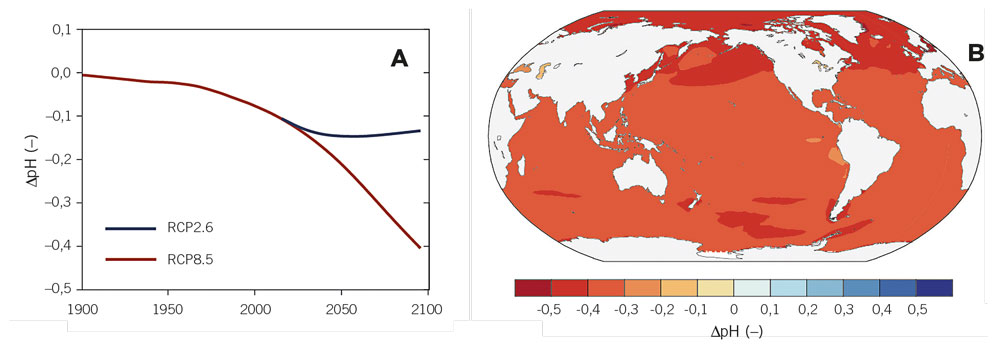
Figure 3. A) Simulation of past and future changes in global oceanic surface water pH according to optimistic (RCP2.6) and pessimistic (RCP8.5) scenarios. B) Changes in the surface pH of the oceans by the end of the twenty-first century in relation to the 1850–1900 period, according to a pessimistic scenario (RCP8.5). See Fuss et al. (2014) for more information on Representative Concentration Pathways (RCP) emission scenarios. / Source: IPCC (2019, p. 470)
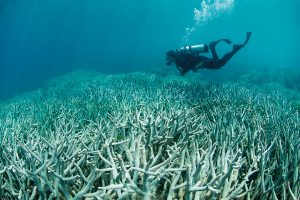
Figure 4. Acidification, caused by the dissolution of carbon dioxide in water, represents an additional stress on corals and other organisms that build calcium carbonate structures, because they are less able to regenerate after a bleaching process such as the one shown in the picture, taken in Australia’s Great Barrier Reef. / Photo: The Ocean Agency / XL Catlin Seaview Survey
«This change in water chemistry has many implications for marine organisms, especially those that build calcium carbonate structures»
Under warmer conditions, oxygen has a greater tendency to escape from the water into the air. Unlike warming and acidification, which are more intense at the oceanic surface, in the open sea the problem of global deoxygenation is more pronounced in deeper depths, while the more superficial layers are usually highly oxygenated. The process also depends on the ocean basin. The Atlantic Ocean, for example, is better ventilated and is, therefore, better oxygenated than the Indian or Pacific Oceans, with the latter having the lowest levels of oxygen, particularly in its intermediate layers. Oxygen levels in the equatorial Pacific Ocean, at a depth of between 200 and 1,000 m, are particularly low. As for marine animals, only species adapted to living in such chemical conditions, like certain species of demersal fish or some cephalopods such as the giant squid can be found living in these oxygen-poor regions. The warming of the waters also results in greater stratification of the water column and less ventilation which, in turn, contributes to the progressive deoxygenation. In addition, warmer conditions boost the metabolism of marine organisms and, as a result, increases their demand for oxygen for respiration. In some coastal areas, the excessive production of organic matter due to eutrophication processes can also lead to the formation of localised areas with low levels of oxygen. Some studies suggest that, over the last five decades, the oxygen content of the oceans has decreased by 2 % (Schmidtko et al., 2017). Depending on future emissions scenarios, dissolved oxygen concentrations in the ocean water column could fall by a further 1.8 % to 3.5 % on average by the end of the twenty-first century, according to the most optimistic or pessimistic scenarios, respectively (IPCC, 2019; see Figure 5).
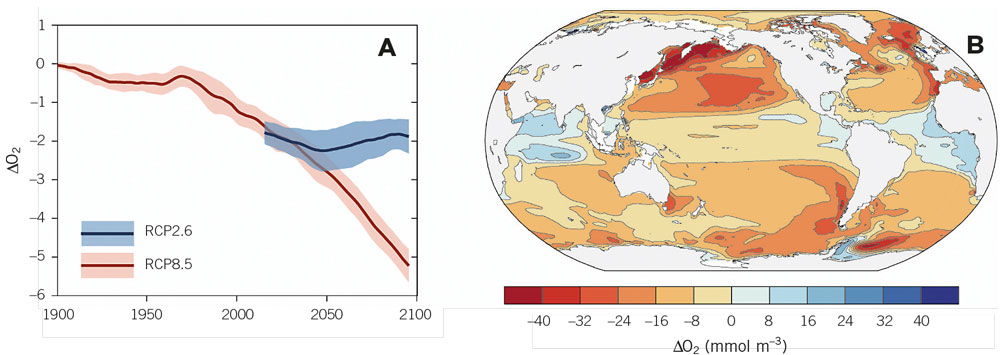
Figure 5. A) Simulation of past and future changes in the average dissolved oxygen concentration in the water column between 100 and 600 m depth, according to optimistic (RCP2.6) and pessimistic scenarios (RCP8.5). B) Spatial changes in the average dissolved oxygen concentration in the water column between 100 and 600 m depth by the end of the twenty-first century in relation to the 1850–1900, period according to a pessimistic scenario (RCP8.5). See Fuss et al. (2014) for more information on RCP emission scenarios. / Source: IPCC (2019, p. 470)
How to tackle the problem: international agreements
At the 2015 United Nations Climate Change Conference in Paris, a major international agreement was reached to reduce CO2 emissions, which entered into force at the end of 2016. This agreement required developed countries to commit to progressively reducing emissions with the aim of keeping the increase in average global temperature below 2 ℃ compared to pre-industrial values, taking into account that the increase now stands at 1 ℃. However, the commitments adopted so far by the different countries still leave us far from the objective set out in Paris. Later, a special report (IPCC, 2018) warned that this 2 ℃ warming, despite being an ambitious objective, would still be insufficient to avoid triggering irreversible changes. Specifically in relation to the oceans, it will be vital to limit warming to 1.5 ℃ to reduce the risks posed to marine biodiversity, fishing, and marine ecosystems, as well as to their functions and the ecosystem services they provide to humans. Among the effects of climate change on the most at-risk ecosystems, this report highlighted the recent alarming decline in Arctic marine ice as well as the changes in the ecosystems associated with tropical coral reefs. The Paris agreement, therefore, is a good international starting point for addressing the root cause of all these global changes (and specially, the disproportionate anthropogenic release of CO2) but ideally, it should be much more ambitious in terms of aiming to reduce emissions. In fact, as denounced in scientific reports and articles (see Höhne et al., 2020; United Nations Environment Programme, 2019), not much has been done in the last decade in terms of individual countries’ policies to move in this direction.
Potential solutions in the oceans themselves
Some of the solutions to help reduce the emissions of CO2 and other greenhouse gases can, in fact, be found in the oceans themselves. For example, a recent report suggested a number of ocean-based fields of action that could be used to mitigate emissions (Hoegh-Guldberg, 2019). The oceans offer, for instance, great potential for renewable energy through the use of the energy stored in marine currents, tides, and waves, or with the construction of offshore wind farms. However, it must also be considered that many of these are still in the initial research or pilot phases and, therefore, will require a great deal more research and effort before their implementation. Emissions from maritime transport, which currently represent approximately 2–3 % of all anthropogenic CO2 emissions, must also be reduced. This can be achieved by increasing energy efficiency, i.e., by reducing the energy required to move ships, or by replacing fossil fuels with other fuels that do not produce carbon emissions (e.g., hydrogen, ammonia, or some biofuels). As for oceanic carbon sequestration, the so-called marine forests, which include coastal ecosystems such as kelp forests, Posidonia meadows (Figure 6), wetlands, or marshes, are very effective carbon sinks (collectively known as «blue carbon»), which can capture ten times more carbon per hectare than terrestrial ecosystems such as tropical forests (Mcleod et al., 2011).
«We are the last generation capable of avoiding irreversible and catastrophic changes, and the first that is already beginning to suffer their effects»
Thus, protecting these ecosystems, which are highly degraded by anthropogenic activities and global warming, will be key to reducing CO2 because they play an important role in producing oxygen and protecting the coast from marine storms, cyclones, and tsunamis, and from the rise in sea levels resulting from climate change. Also related to marine organisms, macroalgae crops have a great potential as replacements for oil-derived compounds or even as a possible food supplement to reduce methane emissions from ruminant livestock (Machado et al., 2016).
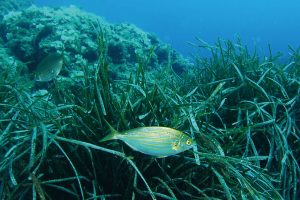
Figure 6. The oceans can play an important role agents in the mitigation and reduction of carbon dioxide emissions, either as potential generators of renewable energy or through carbon sequestration. Offshore forests, such as the Posidonia oceanica meadows shown in the image, are effective carbon sinks. / Photo: Unsplash
Urgent action must be taken
This brand-new decade will be key in trying to reverse this problem or, at least, to minimise its effects as far as possible. As stated in the latest Emissions Gap Report from the UN Environment Programme (2019), we have very little room for manoeuvre; we cannot afford another decade without taking drastic action or it will be impossible to achieve the maximum warming target of 1.5 ℃ or even 2.0 ℃ (Höhne et al., 2020). We require urgent and concerted action by every country and all our industrial sectors. Current policies on energy efficiency must be extended and strengthened, transport and mobility with minimal CO2 emissions must be promoted, and an ambitious transition towards renewable energies must be promoted, while also bearing in mind that the planet’s resources are limited, not only regarding fossil fuels. We are the last generation capable of avoiding irreversible and catastrophic changes, and the first that is already beginning to suffer their effects. In addition, we should not lose sight of the fact that the problem of climate change and global change can only be solved by a major social transformation. We should all ask ourselves what kind of world we want to live in and leave to future generations. It is very important that we become aware of all these environmental problems, the effects they have at the planetary scale, and the magnitude of our footprint, which is very comparable to the geological processes of the past.
References
Alley, R. B. (2014). The two-mile time machine: Ice cores, abrupt climate change, and our future (Updated Edition). Princeton University Press.
Delmas, R. J., Ascencio, J.-M., & Legrand, M. (1980). Polar ice evidence that atmospheric CO2 20,000 yr BP was 50 % of present. Nature, 284, 155–157. https://doi.org/10.1038/284155a0
Friedlingstein, P., Jones, M. W., O’Sullivan, M., Andrew, R. M., Hauck, J., Peters, G. P., Peters, W., Pongratz, J., Sitch, S., Le Quéré, C., Bakker, D. C. E., Canadell, J. G., Ciais, P., Jackson, R. B., Anthoni, P., Barbero, L., Bastos, A., Bastrikov, V., Becker, M., … Zaehle, S. (2019). Global carbon budget 2019. Earth System Science Data, 11, 1783–1838. https://doi.org/10.5194/essd-11-1783-2019
Fuss, S., Canadell, J. G., Peters, G. P., Tavoni, M., Andrew, R. M., Ciais, P., Jackson, R. B., Jones, C. D., Kraxner, F., Nakicenovic, N., Le Quéré, C., Raupach, M. R., Sharifi, A., Smith, P., & Yamagata, Y. (2014). Betting on negative emissions. Nature Climate Change, 4, 850–853. https://doi.org/10.1038/nclimate2392
GBRMPA. (2017). Final report: 2016 coral bleaching event on the Great Barrier Reef. GBRMPA (Great Barrier Reef Marine Park Authority). http://elibrary.gbrmpa.gov.au/jspui/bitstream/11017/3206/1/Final-report-2016-coral-bleaching-GBR.pdf
Global Carbon Project. (2019). Global carbon budget 2019. https://www.globalcarbonproject.org/carbonbudget/19/files/GCP_CarbonBudget_2019.pdf
Gruber, N. (2011). Warming up, turning sour, losing breath: Ocean biogeochemistry under global change. Philosophical Transactions of the Royal Society A: Mathematical, Physical and Engineering Sciences, 369(1943), 1980–1996. https://doi.org/10.1098/rsta.2011.0003
Hoegh-Guldberg, O. (Coord.). (2019). The ocean as a solution to climate change: Five opportunities for action. World Resources Institute. https://www.ourdynamicplanet.com/wp-content/uploads/2019/09/HLP_Ocean_Solution_Climate_Change.pdf
Höhne, N., den Elzen, M., Rogelj, J., Metz, B., Fransen, T., Kuramochi, T., Olhoff, A., Alcamo, J., Winkler, H., Fu, S., Schaeffer, M., Schaeffer, R., Peters, G. P., Maxwell, S., & Dubash, N. K. (2020). Emissions: World has four times the work or one-third of the time. Nature, 579, 25–28. https://doi.org/10.1038/d41586-020-00571-x
IPCC. (2018). Global Warming of 1.5 °C. An IPCC Special Report on the impacts of global warming of 1.5 ℃ above pre-industrial levels and related global greenhouse gas emission pathways, in the context of strengthening the global response to the threat of climate change, sustainable development, and efforts to eradicate poverty. V. Masson-Delmotte, P. Zhai, H.-O. Pörtner, D. Roberts, J. Skea, P.R. Shukla, ... T. Waterfield (Eds.). IPCC. https://www.ipcc.ch/site/assets/uploads/sites/2/2019/06/SR15_Full_Report_High_Res.pdf
IPCC. (2019). IPCC special report on the ocean and cryosphere in a changing climate. H.-O. Pörtner, D. C. Roberts, V. Masson-Delmotte, P. Zhai, M. Tignor, E. Poloczanska, ... N. M. Weyer (Eds.). https://www.ipcc.ch/site/assets/uploads/sites/3/2019/12/SROCC_FullReport_FINAL.pdf
Lüthi, D., Le Floch, M., Bereiter, B., Blunier, T., Barnola, J.-M., Siegenthaler, U., Raynaud, D., Jouzel, J., Fischer, H., Kawamura, K., & Stocker, T. F. (2008). High-resolution carbon dioxide concentration record 650,000-800,000 years before present. Nature, 453, 379–382. https://doi.org/10.1038/nature06949
Machado, L., Magnusson, M., Paul, N. A., Kinley, R., de Nys, R., & Tomkins, N. (2016). Dose-response effects of Asparagopsis taxiformis and Oedogonium sp. on in vitro fermentation and methane production. Journal of Applied Phycology, 28, 1443–1452. https://doi.org/10.1007/s10811-015-0639-9
Mcleod, E., Chmura, G. L., Bouillon, S., Salm, R., Björk, M., Duarte, C. M., Lovelock, C. E., Schlesinger, W. H., & Silliman, B. R. (2011). A blueprint for blue carbon: Toward an improved understanding of the role of vegetated coastal habitats in sequestering CO2. Frontiers in Ecology and the Environment, 9(10), 552–560. https://doi.org/10.1890/110004
Pelejero, C., Calvo, E., & Hoegh-Guldberg, O. (2010). Paleo-perspectives on ocean acidification. Trends in Ecology & Evolution, 25(6), 332–344. https://doi.org/10.1016/j.tree.2010.02.002
Schmidtko, S., Stramma, L., & Visbeck, M. (2017). Decline in global oceanic oxygen content during the past five decades. Nature, 542, 335–339. https://doi.org/10.1038/nature21399
United Nations Environment Programme. (2019). Emissions gap report 2019. UNEP.
Yan, Y., Bender, M. L., Brook, E. J., Clifford, H. M., Kemeny, P. C., Kurbatov, A. V., Mackay, S., Mayewski, P. A., Ng, J., Severinghaus, J. P., & Higgins, J. A. (2019). Two-million-year-old snapshots of atmospheric gases from Antarctic ice. Nature, 574, 663–666. https://doi.org/10.1038/s41586-019-1692-3





